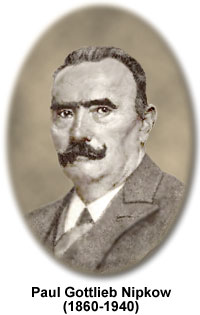Paul Gottlieb Nipkow
(1860-1940)

Paul Gottlieb Nipkow was a German engineer and inventor who proposed the world's first electromechanical television system. He was born on August 22, 1860 in Lauenberg, Germany and studied at the University of Berlin. It was during his time as a student there that he developed the idea he is best known for.
While some nineteenth century scientists, such as Guglielmo Marconi, concentrated upon transmitting audio signals, Nipkow was interested in the notion of transmitting a visual signal. At the young age of 23, he proposed a method that was capable of the task and received a patent for his invention. What Nipkow referred to as an electric telescope, was actually the forerunner of modern television. The innovative system was based upon a simple device known as the Nipkow disk.
The Nipkow disk was composed of either metal or cardboard, perforated with a series of square holes arranged in a spiral pattern, with each hole slightly nearer to the center than the previous hole. As the Nipkow disk was rotated rapidly in front of a light-sensitive selenium cell on which a lens formed an image, an intense light was shined through the holes. Though each hole essentially "scanned" a small section of the image, together they created a full replica of the image in a single rotation of the disk. The image could then be converted into an electrical signal by connecting the selenium photoelectric cell to an electric current. The image was reproduced at a receiver where an identical disk was synchronized with the first in front of a lamp whose brightness changed according to the received signal.
Nipkow once used his device to transmit a visual image from London to Paris, but the system was never developed for commercial use. Ironically, at the time, investors could not foresee a practical use for it, and therefore, Nipkow received little recognition during his lifetime for the feat. He spent most of his life as a railway engineer and died in Berlin, Germany on August 24, 1940. However, Nipkow paved the way for future developments in television and the horizontal-scanning method he first conceived continues to be an essential element in modern-day electronics.
The Nipkow disk is currently used extensively in reflected light confocal scanning microscopy to produce images that can be viewed in real time through the microscope eyepieces. The rotating, perforated disk fulfills the requirements of both point illumination and detection when a modulated light beam is passed through the numerous holes drilled along a spiral. Each illuminated pinhole on the spinning disk is imaged by the objective to a diffraction-limited spot on the specimen. Light reflected from the specimen can be observed in the eyepieces (or with a CCD camera system) after it has passed back through a conjugate pinhole in the Nipkow disk. Several thousand points are simultaneously illuminated on the disk to mimic the effect of several thousand confocal microscopes running in parallel. The rapidly spinning disk fills spaces between the holes to create a real-time confocal image.
